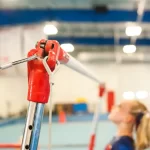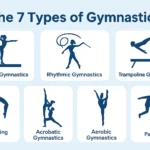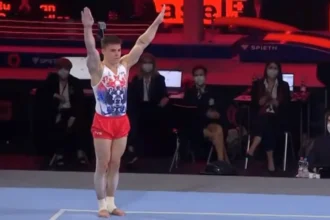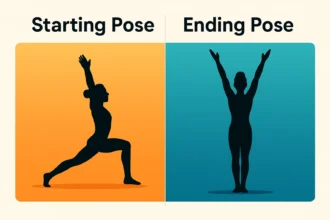Vaulting in gymnastics is all about speed, power, and perfect timing. Some vaults are so difficult that only a few gymnasts have ever landed them successfully. Let’s take a look at the toughest vaults ever performed and what makes them so challenging!
Most Difficult Vaults in Women’s Artistic Gymnastics (WAG)
| Vault Name | Entry Type | Flipping & Twisting | Difficulty Score |
|---|---|---|---|
| Yurchenko Double Pike (Biles II) | Yurchenko (round-off, back handspring) | Two backflips in pike, no twists | 6.4 |
| Produnova | Handspring | Two front flips, no twists | 6.0 |
| Cheng | Round-off, half-on | Layout backflip with 1.5 twists | 5.6 |
| Tsukahara 2½ | Tsukahara | Layout backflip with 2½ twists | 5.6 |
| Yeo | Handspring | Layout backflip with double twist | 5.6 |
1. Biles II – Yurchenko Double Pike
Difficulty Score: 6.4
First Performed by: Simone Biles (USA), 2021 U.S. Classic
Recognized in the Code of Points: 2023 World Championships
The Biles II is the hardest vault ever performed in women’s gymnastics. It begins with a round-off onto the springboard and a back handspring onto the vault table. From there, the gymnast launches into two fully rotated backflips in a piked position—without a single twist—before landing.
Why it’s so hard:
- Pure rotation power – No twists to help generate lift; height and speed must come entirely from block and run.
- Tight pike position – Limits visibility of the floor, making landings harder to control.
- Tiny margin for error – Even the smallest mistimed block can cause dangerous under-rotation.
Biles made history landing this at the 2021 U.S. Classic, and it was officially named in the Code after she performed it at the 2023 World Championships in Antwerp.
2. The Cheng
Difficulty Score: 5.6
First Performed by: Cheng Fei (China), 2005 World Championships
The Cheng uses a half-on entry. The gymnast performs a round-off onto the springboard, then a half turn onto the vault table, before launching into a stretched layout with 1.5 twists.
Why it’s so hard:
- Twist-on entry – Requires turning onto the table without losing blocking power.
- Complex coordination – Balancing height, rotation, and twist timing while staying stretched.
- Landing control – Twisting disorients spotting, making stuck landings rare.
The Cheng has become a staple in elite finals because it combines high difficulty with better consistency than the riskiest vaults.
3. Tsukahara 2½
Difficulty Score: 5.6
Origins: A modern variation of Mitsuo Tsukahara’s original 1970s vault
This version of the Tsukahara increases difficulty by adding 2½ twists in a layout position after the quarter-turn entry.
Why it’s so hard:
- Rapid twisting – Completing 2½ twists in layout requires elite air awareness.
- Landing risk – The extra half twist beyond a double makes spotting the ground much harder.
- High power demand – Requires maximum block height to allow time for the added twist.
4. The Produnova – “Vault of Death”
Difficulty Score: 6.0
First Performed by: Yelena Produnova (Russia), 1999 Universiade
This vault starts with a front handspring onto the table, followed by two tucked front flips before landing. Nicknamed the “Vault of Death,” it has gained fame as one of the most dangerous skills in gymnastics.
Why it’s so hard:
- Blind landing – The gymnast can’t see the floor until the last instant.
- Severe injury risk – Under-rotation can lead to catastrophic crashes.
- Raw power requirement – Demands massive height from a front-entry block.
Very few gymnasts dare attempt this vault, and even fewer have landed it cleanly.
5. The Yeo
Difficulty Score: 5.6
First Performed by: Yeo Seo-jeong (South Korea), 2019 Korea Cup
The Yeo combines a handspring entry with a double-twisting layout, blending forward entry with twisting power.
Why it’s so hard:
- Power + precision – The front entry requires huge block height to complete the twists.
- Double twist timing – Perfect technique is needed to avoid over- or under-rotation.
- Landing stability – Twisting often disrupts body alignment on landing.
Yeo Seo-jeong’s bronze medal at Tokyo 2020 made her the first South Korean woman to medal in Olympic gymnastics.
Most Difficult Vaults in Men’s Artistic Gymnastics (MAG)
| Vault Name | Entry Type | Flipping & Twisting | Difficulty Score |
|---|---|---|---|
| Yang Hak Seon | Handspring | Layout backflip, triple twist | 6.0 |
| Ri Se Gwang | Tsukahara | Full-twisting double back tuck | 6.0 |
| Ri Se Gwang 2 | Handspring | Double piked front, half twist | 6.0 |
| Shirai II | Yurchenko | Layout backflip, 3½ twists | 6.0 |
| Tsukahara 3½ | Tsukahara | Layout backflip, 3½ twists | 6.0 |
1. Yang Hak Seon – Front Handspring Triple Twist
Difficulty Score: 6.0
First Performed by: Yang Hak-seon (South Korea), 2011 World Championships
A handspring entry into a layout backflip with three full twists.
Why it’s so hard:
- Blind landing – From a front-entry, spotting the floor is delayed.
- Triple twist in layout – Requires exceptional twisting speed and core control.
- Explosive block – Must generate huge height for three twists in time.
Yang used this vault to secure Olympic gold in 2012.
2. Ri Se Gwang – Full-Twisting Double Tsukahara
Difficulty Score: 6.0
First Performed by: Ri Se Gwang (North Korea), 2009 World Championships
A Tsukahara-style quarter-turn entry into two tucked backflips with a full twist.
Why it’s so hard:
- Extreme air mechanics – Two flips plus a twist in under two seconds.
- Short takeoff window – Tsukahara block must be perfectly timed.
- No margin for error – Any misjudged twist leads to dangerous landings.
3. Ri Se Gwang 2 – Handspring Double Piked Front with Half Twist
Difficulty Score: 6.0
First Performed by: Ri Se Gwang, 2008 Asian Championships
A handspring vault leading into two piked front flips with a half twist.
Why it’s so hard:
- Piked shape – Rotates slower than tuck, increasing risk.
- Blind landing – Forward flips hide the floor until the very end.
- Maximal block power – Requires explosive speed and height to complete.
4. Shirai II – Yurchenko 3½ Twist
Difficulty Score: 6.0
First Performed by: Kenzo Shirai (Japan), 2016 Olympics
A Yurchenko entry vault with 3½ twists in layout position—1260° of rotation.
Why it’s so hard:
- Rapid twisting in layout – Must maintain a perfectly straight body while twisting at top speed.
- Complex orientation – Twisting past triple limits the gymnast’s ability to spot the floor.
5. Tsukahara 3½
Difficulty Score: 6.0
First Performed by: Jake Jarman (Great Britain), 2023 World Championships
A Tsukahara entry into 3½ twists in layout.
Why it’s so hard:
- Maximum twisting load – 1260° of rotation after a quarter-on entry.
- Landing difficulty – Spotting the ground is nearly impossible until the last second.
Final Thoughts
In women’s gymnastics, the Biles II stands as the most difficult vault ever landed, redefining what’s possible. On the men’s side, vaults like the Shirai II and Yang Hak Seon push twisting and flipping to human extremes.
These vaults represent the absolute limits of gymnastics. They combine violent acceleration, split-second timing, and near-perfect body control.













